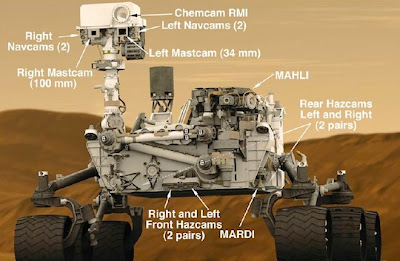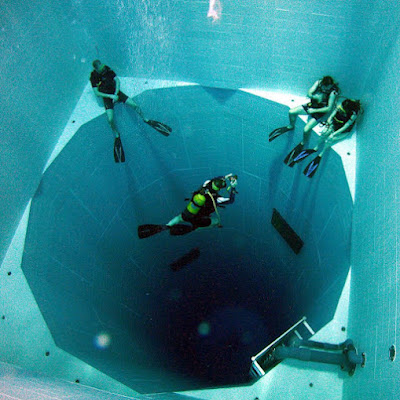One of the best parts of having NASA’s Curiosity rover on Mars is the incredible images that it’s going to start beaming back to viewers on Earth.
After the probe’s safe landing, it sent several pictures of its wheels on the ground to mission control to let engineers know that everything was okay. But these dusty, close-up images cannot compare to the snapshots that the rover will soon be taking.
Curiosity is packed with no fewer than 17 cameras to shoot high-quality photos and videos in black-and-white, color, and 3-D stereo of the Martian landscape. While scientists are no doubt quite eager for the information that these images will contain, most of us will be excited to live vicariously through the rover and experience some breathtaking views on Mars.
First up is the Mars Descent Imager (MARDI), which recently beamed back an amazing video of the rover’s nail-biting descent. MARDI turned on during the final few minutes of the “Seven Minutes of Terror” and recorded a full-color high-definition movie as the ground rushed up to meet the rover. With this film (and the coming high-def version), you get to experience what the wild ride down to the surface looked like.
MARDI is a 2-megapixel wide-angle camera mounted toward the front on the port side of Curiosity. The camera came to life just after the spacecraft’s heat shield jettisoned, taking images of a roughly 2 by 2.5-mile square, with a resolution of about 8 feet per pixel. The final fully-in-focus images came when the rover was about 15 feet off the ground. In addition to a thrilling film, MARDI will provide scientists the opportunity to know exactly where Curiosity landed and learn a bit about the surrounding area.
On the ground, the rover’s main workhorse cameras are the impressive MastCams. Sitting 7 feet above the surface, these 2-megapixel cameras will provide color images and video of the surroundings. Pictures taken with the MastCams will give you a feeling of what it’s like to stand on Mars, but with superhuman eyesight. Different filters can be rotated in front of the MastCams, providing images in visible and near-infrared wavelengths.
The two nearly identical MastCams will combine to take 3-D stereo images. They can focus on objects as close as about 7 feet from the rover and see details down to roughly a few hundred microns. They will see in “true color,” or approximately what your eyes would see if you were there with Curiosity. Natural lighting on Mars tends to be slightly redder than on Earth because of the high amount of dust in the air. So the rover will be taking images with a slight adjustment that gives them a warm, orangey glow similar to sunlight at sunset on Earth to capture this effect. The MastCams will also be taking images without this feature.
One of the biggest requests that scientists had for Curiosity was the addition of a telephoto lens. The previous rovers, Spirit and Opportunity, could see details about as well as a person would on Mars. But MastCam’s right camera has a 100-mm focal-length lens that provides three times the resolution of previous Mars rover cameras. It can distinguish between a football and a basketball from seven football fields away. While the left camera, with its 34-mm lens, can’t see as well, it will provide much wider views – about 15 degrees versus the right camera’s five degree field-of-view.
The MastCams can take full-color 360-degree panoramic images by stitching together 150 individual photos taken in a slowly rotating circle. Finally, the cameras can also take 720p high-definition video at a rate of about 10 frames per second.
For inspecting Martian rocks and soil up close, Curiosity will use its Mars Hand Lens Imager (MAHLI). Sitting on the end of the rover’s robotic arm, MAHLI’s 2-megapixel color camera can focus on an object as close as three-quarters of an inch away. It will act as a microscope, resolving material down to 15 microns, roughly half the diameter of a human hair.
MAHLI will be able to work night and day using four white light LEDs and two ultraviolet LEDs. Images from the camera will be calibrated with a smartphone-sized plaque affixed to the side of the rover that contains color chips, a stair-step pattern for depth, and a 1909 U.S. penny. The penny was chosen as a nod to geologists’ tradition of placing a coin for size reference in close-up photographs of rocks.
The first images from Curiosity came via the machine’s Hazard-Avoidance cameras or Hazcams. These cameras are responsible for making sure Curiosity doesn’t run into any bad obstacles, and can take black-and-white 1-megapixel images of the area underneath and near the rover. There are eight Hazcams arranged in pairs on the probe’s front and back, because it can just as easily drive backwards as forwards. Each camera has a wide-field, fish-eye lens that provides a 124-degree view of the surrounding terrain.
The Hazcams were sheltered behind transparent protective covers immediately after landing, in anticipation of the dust that was kicked up during touchdown, which is why those initial pictures were so splotchy. Those dust covers will be shot off with a small pyrotechnic device to get clearer images. When the rover gets moving, the front Hazcam pairs will take 3D images of possible targets to help scientists plan the motion of Curiosity’s sample-collecting arm.
Curiosity also has two pairs of Navigation cameras (Navcams) mounted up high on its mast. Providing similar image quality as the Hazcams, these cameras will be used to help maneuver the rover to interesting locations. With a fixed-aperture f/12 focus, the Navcams will capture 45-degree square images.
After the probe’s safe landing, it sent several pictures of its wheels on the ground to mission control to let engineers know that everything was okay. But these dusty, close-up images cannot compare to the snapshots that the rover will soon be taking.
Curiosity is packed with no fewer than 17 cameras to shoot high-quality photos and videos in black-and-white, color, and 3-D stereo of the Martian landscape. While scientists are no doubt quite eager for the information that these images will contain, most of us will be excited to live vicariously through the rover and experience some breathtaking views on Mars.
First up is the Mars Descent Imager (MARDI), which recently beamed back an amazing video of the rover’s nail-biting descent. MARDI turned on during the final few minutes of the “Seven Minutes of Terror” and recorded a full-color high-definition movie as the ground rushed up to meet the rover. With this film (and the coming high-def version), you get to experience what the wild ride down to the surface looked like.
MARDI is a 2-megapixel wide-angle camera mounted toward the front on the port side of Curiosity. The camera came to life just after the spacecraft’s heat shield jettisoned, taking images of a roughly 2 by 2.5-mile square, with a resolution of about 8 feet per pixel. The final fully-in-focus images came when the rover was about 15 feet off the ground. In addition to a thrilling film, MARDI will provide scientists the opportunity to know exactly where Curiosity landed and learn a bit about the surrounding area.
On the ground, the rover’s main workhorse cameras are the impressive MastCams. Sitting 7 feet above the surface, these 2-megapixel cameras will provide color images and video of the surroundings. Pictures taken with the MastCams will give you a feeling of what it’s like to stand on Mars, but with superhuman eyesight. Different filters can be rotated in front of the MastCams, providing images in visible and near-infrared wavelengths.
The two nearly identical MastCams will combine to take 3-D stereo images. They can focus on objects as close as about 7 feet from the rover and see details down to roughly a few hundred microns. They will see in “true color,” or approximately what your eyes would see if you were there with Curiosity. Natural lighting on Mars tends to be slightly redder than on Earth because of the high amount of dust in the air. So the rover will be taking images with a slight adjustment that gives them a warm, orangey glow similar to sunlight at sunset on Earth to capture this effect. The MastCams will also be taking images without this feature.
One of the biggest requests that scientists had for Curiosity was the addition of a telephoto lens. The previous rovers, Spirit and Opportunity, could see details about as well as a person would on Mars. But MastCam’s right camera has a 100-mm focal-length lens that provides three times the resolution of previous Mars rover cameras. It can distinguish between a football and a basketball from seven football fields away. While the left camera, with its 34-mm lens, can’t see as well, it will provide much wider views – about 15 degrees versus the right camera’s five degree field-of-view.
The MastCams can take full-color 360-degree panoramic images by stitching together 150 individual photos taken in a slowly rotating circle. Finally, the cameras can also take 720p high-definition video at a rate of about 10 frames per second.
For inspecting Martian rocks and soil up close, Curiosity will use its Mars Hand Lens Imager (MAHLI). Sitting on the end of the rover’s robotic arm, MAHLI’s 2-megapixel color camera can focus on an object as close as three-quarters of an inch away. It will act as a microscope, resolving material down to 15 microns, roughly half the diameter of a human hair.
MAHLI will be able to work night and day using four white light LEDs and two ultraviolet LEDs. Images from the camera will be calibrated with a smartphone-sized plaque affixed to the side of the rover that contains color chips, a stair-step pattern for depth, and a 1909 U.S. penny. The penny was chosen as a nod to geologists’ tradition of placing a coin for size reference in close-up photographs of rocks.
 |
| CURIOSITY SNAPS ITS FIRST COLOR PHOTO OF MARS |
The Hazcams were sheltered behind transparent protective covers immediately after landing, in anticipation of the dust that was kicked up during touchdown, which is why those initial pictures were so splotchy. Those dust covers will be shot off with a small pyrotechnic device to get clearer images. When the rover gets moving, the front Hazcam pairs will take 3D images of possible targets to help scientists plan the motion of Curiosity’s sample-collecting arm.
Curiosity also has two pairs of Navigation cameras (Navcams) mounted up high on its mast. Providing similar image quality as the Hazcams, these cameras will be used to help maneuver the rover to interesting locations. With a fixed-aperture f/12 focus, the Navcams will capture 45-degree square images.















.jpg)
No comments:
Post a Comment